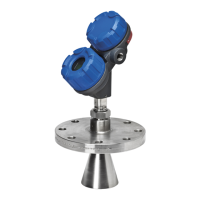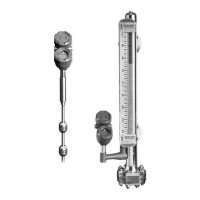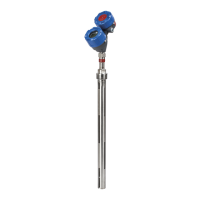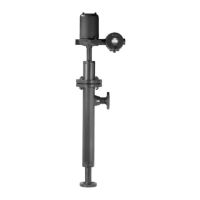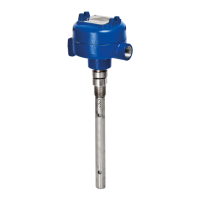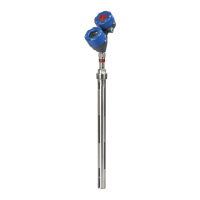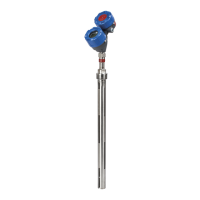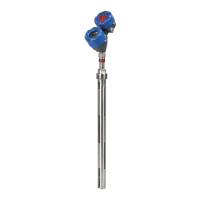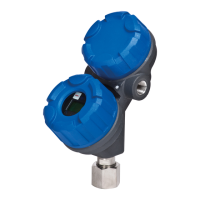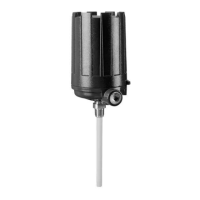How to fix Magnetrol Radar software error?
- KKimberly PriceAug 12, 2025
To resolve software errors, verify the level reading and, if incorrect, check the configuration. If issues persist, recalibration at the factory may be necessary.
How to fix Magnetrol Radar software error?
To resolve software errors, verify the level reading and, if incorrect, check the configuration. If issues persist, recalibration at the factory may be necessary.
What should I check for Magnetrol Radar software error?
To address software errors, confirm the proper configuration and check the measurement type. Also, saving a fresh Echo Rejection Curve might help.
What to do if Magnetrol Radar software error relates to vessel dimensions?
To address software errors, check settings related to vessel dimensions and custom table entries. If issues persist, it might be necessary to return the transmitter to the factory for recalibration.
What to do if Magnetrol Radar software error occurs because liquid reaches blocking distance?
To troubleshoot software errors, make sure liquid cannot reach the blocking distance.
What to do if Magnetrol Radar software error is related to loop resistance?
To troubleshoot software errors, verify loop resistance and replace the loop power supply if necessary. Also, perform the Adjust Analog Output maintenance procedure.
How to fix Magnetrol Radar software error by cleaning gold pin?
To fix software errors, torque the HF nut, clean the gold pin on the transmitter and the socket on the antenna, and check settings such as Fiducial Gain Window Increase Fid Gain. Contact MAGNETROL Technical Support if the problem persists.
What to do if Magnetrol Radar software error occurs in cold conditions?
To resolve software errors, insulate the transmitter or relocate it to a warmer area.
How to adjust rate of change setting on Magnetrol Radar to fix software error?
To resolve software errors related to rate of change, confirm the actual rate of change and adjust the rate of change setting if needed.
Augments or clarifies operating steps without actions.
Alerts to conditions that could injure personnel or damage equipment.
Identifies potentially dangerous situations or serious hazards.
Prepare for QuickStart Installation by gathering necessary equipment, tools, and information.
Lists recommended tools and equipment for QuickStart Installation.
Gathers necessary information for configuring the transmitter via the Setup Wizard.
Instructions for mounting the antenna to the vessel.
Instructions for mounting the transmitter onto the antenna.
Details the parameters available within the Setup Wizard for configuration.
Explains how to enter numerical data using the UP, DOWN, BACK, ENTER buttons.
Procedures for unpacking the instrument and checking contents.
Recommended steps to reduce the risk of component failure due to static electricity.
Ensures correct antenna connection, regulations, and wiring for installation.
Lists recommended tools and equipment for installation.
Discusses basic conditions affecting radar applications and antenna selection.
Ensures correct antenna mounting, considering process specs and location.
Guidance on optimal mounting location for unobstructed signal path.
Information on how beam patterns affect installation location and performance.
Wiring instructions for general purpose and Division 2 hazardous area installations.
Steps for configuring the transmitter using a test bench setup.
Explains how to navigate the transmitter's menu structure using the push buttons.
Describes the method for selecting configuration data from a list.
Describes the information presented on the transmitter's Home Screen.
Displays model, serial number, and firmware revision information.
Configures measurement type, units, antenna, dielectric, turbulence, etc.
Settings for ignoring unwanted signals and false targets.
Displays model, serial number, and firmware revision information.
Configures measurement type, units, antenna, dielectric, turbulence, etc.
Configuration parameters for volume measurement applications.
Configures primary variable, setpoints, alarm types, and damping.
Customizes display settings such as language, status symbols, and tags.
Flow setup parameter for the totalizer display.
Adjusts the sensitivity of the radar signal detection.
Configures HART poll address and loop current mode.
Accesses factory reset and calibration parameters.
Explains how to connect a HART communicator for configuration.
Describes the communicator display and menu structure.
Lists HART versions compatible with the R86 software.
Displays device identification information.
Parameters for basic configuration like measurement type and units.
Configuration settings for volume measurement.
Accesses advanced configuration settings for the transmitter.
Options for factory reset and calibration.
Provides a general overview of the PULSAR Model R86 transmitter.
Explains the principles of Pulse Burst Radar technology.
Defines Bottom Blocking Distance and its impact on level measurement.
Explains configuration for volume calculations using built-in vessel types.
Explains diagnostic indicators following NAMUR NE 107 guidelines.
Configures automatic waveform capture for diagnostic events or time.
Records significant diagnostic and configuration events with timestamps.
Provides on-demand help for menu items and parameters.
Logs measured values over time for analysis.
Details Explosion Proof certifications and specifications for various regions.
Details Intrinsically Safe certifications and specifications for various regions.
Lists FCC, ISED, and ETSI telecommunications compliance.
Entity parameters for intrinsically safe and explosion-proof hazardous locations.
Specific conditions and precautions for installation and operation.
Entity parameters for explosion-proof hazardous locations.
Specific conditions and precautions for installation and operation.
Entity parameters for explosion-proof hazardous locations.
Specific conditions and precautions for installation and operation.
Entity parameters for various hazardous location classifications.
Parameters for intrinsically safe associated apparatus in unclassified locations.
Key functional specifications for the transmitter, including input, output, and interface.
Specifies the operating temperature ranges for the device.
Graphical representation of safe operating areas for IS and XP installations.
Charts showing pressure and temperature ratings for standard and isolation antennas.
Graphical representation of operating temperature ranges with seal options.
Lists available replacement parts for standard models.
Explains the coding system for PULSAR Model R86 transmitter model numbers.
Explains the coding system for PULSAR Model R86 Radar Antenna model numbers.
Utilizes the Echo Rejection feature to ignore unwanted signals in the measurement range.
Outlines Magnetrol's warranty and service policy for product repair or replacement.
Procedure for returning materials for processing, including RMA form requirements.
Augments or clarifies operating steps without actions.
Alerts to conditions that could injure personnel or damage equipment.
Identifies potentially dangerous situations or serious hazards.
Prepare for QuickStart Installation by gathering necessary equipment, tools, and information.
Lists recommended tools and equipment for QuickStart Installation.
Gathers necessary information for configuring the transmitter via the Setup Wizard.
Instructions for mounting the antenna to the vessel.
Instructions for mounting the transmitter onto the antenna.
Details the parameters available within the Setup Wizard for configuration.
Explains how to enter numerical data using the UP, DOWN, BACK, ENTER buttons.
Procedures for unpacking the instrument and checking contents.
Recommended steps to reduce the risk of component failure due to static electricity.
Ensures correct antenna connection, regulations, and wiring for installation.
Lists recommended tools and equipment for installation.
Discusses basic conditions affecting radar applications and antenna selection.
Ensures correct antenna mounting, considering process specs and location.
Guidance on optimal mounting location for unobstructed signal path.
Information on how beam patterns affect installation location and performance.
Wiring instructions for general purpose and Division 2 hazardous area installations.
Steps for configuring the transmitter using a test bench setup.
Explains how to navigate the transmitter's menu structure using the push buttons.
Describes the method for selecting configuration data from a list.
Describes the information presented on the transmitter's Home Screen.
Displays model, serial number, and firmware revision information.
Configures measurement type, units, antenna, dielectric, turbulence, etc.
Settings for ignoring unwanted signals and false targets.
Displays model, serial number, and firmware revision information.
Configures measurement type, units, antenna, dielectric, turbulence, etc.
Configuration parameters for volume measurement applications.
Configures primary variable, setpoints, alarm types, and damping.
Customizes display settings such as language, status symbols, and tags.
Flow setup parameter for the totalizer display.
Adjusts the sensitivity of the radar signal detection.
Configures HART poll address and loop current mode.
Accesses factory reset and calibration parameters.
Explains how to connect a HART communicator for configuration.
Describes the communicator display and menu structure.
Lists HART versions compatible with the R86 software.
Displays device identification information.
Parameters for basic configuration like measurement type and units.
Configuration settings for volume measurement.
Accesses advanced configuration settings for the transmitter.
Options for factory reset and calibration.
Provides a general overview of the PULSAR Model R86 transmitter.
Explains the principles of Pulse Burst Radar technology.
Defines Bottom Blocking Distance and its impact on level measurement.
Explains configuration for volume calculations using built-in vessel types.
Explains diagnostic indicators following NAMUR NE 107 guidelines.
Configures automatic waveform capture for diagnostic events or time.
Records significant diagnostic and configuration events with timestamps.
Provides on-demand help for menu items and parameters.
Logs measured values over time for analysis.
Details Explosion Proof certifications and specifications for various regions.
Details Intrinsically Safe certifications and specifications for various regions.
Lists FCC, ISED, and ETSI telecommunications compliance.
Entity parameters for intrinsically safe and explosion-proof hazardous locations.
Specific conditions and precautions for installation and operation.
Entity parameters for explosion-proof hazardous locations.
Specific conditions and precautions for installation and operation.
Entity parameters for explosion-proof hazardous locations.
Specific conditions and precautions for installation and operation.
Entity parameters for various hazardous location classifications.
Parameters for intrinsically safe associated apparatus in unclassified locations.
Key functional specifications for the transmitter, including input, output, and interface.
Specifies the operating temperature ranges for the device.
Graphical representation of safe operating areas for IS and XP installations.
Charts showing pressure and temperature ratings for standard and isolation antennas.
Graphical representation of operating temperature ranges with seal options.
Lists available replacement parts for standard models.
Explains the coding system for PULSAR Model R86 transmitter model numbers.
Explains the coding system for PULSAR Model R86 Radar Antenna model numbers.
Utilizes the Echo Rejection feature to ignore unwanted signals in the measurement range.
Outlines Magnetrol's warranty and service policy for product repair or replacement.
Procedure for returning materials for processing, including RMA form requirements.
| Accuracy | ± 1 cm |
|---|---|
| Output Signal | 4–20 mA HART |
| Power Supply | 24 VDC |
| Process Temperature | -40 to +392 °F (-40 to +200 °C) |
| Process Pressure | 0 to 4 bar |
| Enclosure Rating | Type 4X, IP66 |
| Material | 316L stainless steel |
| Application | Liquid Level Measurement |
